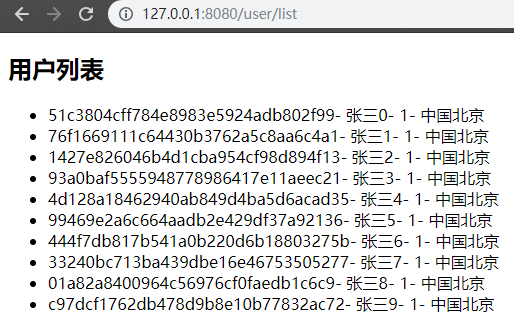閱讀目錄
一、前言
二、集成 Thymeleaf 模板引擎
三、使用 Thymeleaf 模板
回到頂部
一、前言
Thymeleaf 的出現是爲了取代 JSP,雖然 JSP 存在了很長時間,並在 Java Web 開發中無處不在,但是它也存在一些缺陷:
1、JSP 最明顯的問題在於它看起來像HTML或XML,但它其實上並不是。大多數的JSP模板都是採用HTML的形式,但是又摻雜上了各種JSP標籤庫的標籤,使其變得很混亂。
2、JSP 規範是與 Servlet 規範緊密耦合的。這意味着它只能用在基於 Servlet 的Web應用之中。JSP模板不能作爲通用的模板(如格式化Email),也不能用於非Servlet的 Web 應用。
相較於 JSP 來說,Thymeleaf 很好的解決了這些缺點:1、Thymeleaf模板是原生的,不依賴於標籤庫。它能在接受原始 HTML 的地方進行編輯和渲染。
2、因爲它沒有與Servlet規範耦合,因此 Thymeleaf 模板能夠進入JSP所無法涉足的領域。這意味着Thymeleaf模板與JSP不同,它能夠按照原始的方式進行編輯甚至渲染,而不必經過任何類型的處理器。當然,我們需要Thymeleaf來處理模板並渲染得到最終期望的輸出。即便如此,如果沒有任何特殊的處理,home.html也能夠加載到Web瀏覽器中,並且看上去與完整渲染的效果很類似。
Spring boot不建議使用 JSP 開發web。回到頂部
二、集成 Thymeleaf 模板引擎
SpringBoot 對 Thymeleaf 模板引擎的支持也很簡單:
1、pom.xml<dependency><groupId>org.springframework.boot</groupId>
<artifactId>spring-boot-starter-thymeleaf</artifactId>
</dependency>
這時候,SpringBoot 對 Thymeleaf 模板的支持就完成了,我們就能在 Web 開發中使用 Thymeleaf 模板了,簡單吧?
之前的文章有提到 SpringBoot 的關鍵是 “約定俗成”。既然我們選擇了這麼簡單的配置,那麼在開發中就要遵守 SpringBoot 對 Thymeleaf 約定俗成的方案,最重要的一點就是 模板文件放在 templates 目錄下,即模板解析器前綴是 /templates/ ,後綴是 .html 。
2、application.yml
如果不想要所謂約定俗成的方案,想進行一些自定義的配置呢?且看下方:spring:thymeleaf:
prefix: classpath:/templates/
suffix: .html
servlet:
content-type: text/html
enabled: true
encoding: UTF-8
mode: HTML5
cache: false
3、WebConfig.java
如果上面的配置還不能達到你的要求,你想要更細化對 Thymeleaf 的控制,包括配置視圖解析器、模板解析器以及模板引擎這些,那麼請看下面的方案!/**
- 1、ThymeleafViewResolver 接收邏輯視圖名稱將它解析爲視圖
- 2、SpringTemplateEngine會在Spring中啓用Thymeleaf引擎,用來解析模板,並基於這些模板渲染結果
- 3、TemplateResolver會最終定位和查找模板。br/>*/
@Configuration
public class WebConfig {
/**
* 配置 Thymeleaf 視圖解析器 —— 將邏輯視圖名稱解析爲 Thymeleaf 模板視圖
*
* @param springTemplateEngine 模板引擎
* @return
*/
@Bean
public ViewResolver viewResolver(SpringTemplateEngine springTemplateEngine){
ThymeleafViewResolver resolver = new ThymeleafViewResolver();
resolver.setTemplateEngine(springTemplateEngine);
return resolver;
}
/**
* 模板引擎 —— 處理模板並渲染結果
*
* @param templateResolver 模板解析器
* @return
*/
@Bean
public SpringTemplateEngine springTemplateEngine(ITemplateResolver templateResolver) {
SpringTemplateEngine springTemplateEngine = new SpringTemplateEngine();
springTemplateEngine.setTemplateResolver(templateResolver);
return springTemplateEngine;
}
/**
* 模板解析器 —— 加載 Thymeleaf 模板
*
* @return
*/
@Bean
public ITemplateResolver templateResolver() {
SpringResourceTemplateResolver templateResolver = new SpringResourceTemplateResolver();
templateResolver.setPrefix("classpath:/templates/");
templateResolver.setSuffix(".html");
templateResolver.setTemplateMode(TemplateMode.HTML);
templateResolver.setCacheable(false);
templateResolver.setTemplateMode("HTML5");
return templateResolver;
}}
三、使用 Thymeleaf 模板
做好了上面的配置後,讓我們來看看如何在 SpringBoot 中使用 Thymeleaf 模板吧:
1、模板文件 — /templates/user/list.html<!DOCTYPE html><html xmlns:th="http://www.thymeleaf.org">
<head>
<meta charset="UTF-8" />
<title>Insert title here</title>
</head>
<body>
<h2>用戶列表</h2>
<div>
<ul>
<li th:each="user:${users}">
<span th:text="${user.uuid}"></span>-
<span th:text="${user.name}"></span>-
<span th:text="${user.age}"></span>-
<span th:text="${user.address}"></span>
</li>
</ul>
</div>
</body>
</html>
2、控制層 — ModelAndViews
這裏 Model 指的是:控制層處理完請求,返回需要渲染的結果;Views 指的是:模板的邏輯視圖名(前後端分離)。@Controller@RequestMapping("/user")
public class UserController {
@RequestMapping("/list")
public String listUser(Model model) {
List<UserDto> userList = new ArrayList<>();
for (int i = 0; i < 10; i++) {
userList.add(new UserDto(UUID.randomUUID().toString().replace("-", ""), "張三" + i, 1, "中國北京"));
}
model.addAttribute("users", userList);
return "user/list";
}}
3、效果

